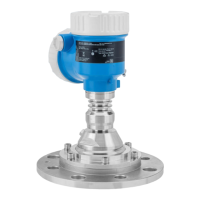Mounting Micropilot FMR67B PROFINET with Ethernet-APL
20 Endress+Hauser
The maximum length of the nozzle H
max
depends on the nozzle diameter D
D H
max
min. 80 to 100 mm (3 to 4 in) 1 450 mm (57 in)
100 to 150 mm (4 to 6 in) 1 800 mm (71 in)
≥ 150 mm (6 in) 2 700 mm (106 in)
In the case of longer nozzles, reduced measuring performance must be expected.
Please note the following:
• The end of the nozzle must be smooth and free from burrs.
• The edge of the nozzle should be rounded.
• Mapping must be performed.
• Please contact the manufacturer's support department for applications with nozzles
that are higher than indicated in the table.
5.3.6 Purge air connection
In applications with strong dust emissions, the integrated purge air connection can prevent
the antenna from becoming clogged. Pulse operation is recommended.
A0046593
4 Antenna with purge air adapter
1 Purge air connection NPT 1/4" or G 1/4"
Purge air pressure range
• Pulse operation :
Max. 6 bar (87 psi)
• Continuous operation:
200 to 500 mbar (3 to 7.25 psi)
Purge air connection
• Tool:
• Open-ended wrench 13 mm (G 1/4")
• Open-ended wrench 14 mm (NPT)
• Open-ended wrench 17 mm (NPT "adapter")
• Min. torque: 6 Nm (4.4 lbf ft)
• Max. torque: 7 Nm
• Always use dry purge air
• In general, purging should only be performed to the extent necessary as excess
purging can cause mechanical damage (abrasion)
5.3.7 Turning the housing
The housing can be rotated up to 380° by loosening the locking screw.

